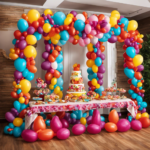Decor
Balloon Designs
Discover the surprising versatility of balloon designs and how they can elevate any event with creativity and charm.

Have you ever thought about how balloon designs are not just attractive to look at but also extremely adaptable?
With over 8 billion balloons being produced in the United States annually, it’s no wonder that balloon designs have become a staple for events and celebrations.
The art of balloon design has evolved beyond simple bouquets and arches, and the possibilities are endless.
As you explore the world of balloon designs, you’ll discover creative ways to elevate your next event and leave a lasting impression on your guests.
Key Takeaways
- Balloon artistry has a rich history, starting in the late 1800s and evolving into modern balloon sculptures in the 1930s.
- Balloon designs can include various types of sculptures, such as ceiling, wall, and pyramid designs, using different types of balloons like gold and paint balloons.
- Customization is a key trend in balloon design, allowing for specific colors, themes, and personalized designs for any occasion.
- DIY balloon design tips include creating stunning entrances with balloon arches, incorporating metallic or translucent balloons for elegance, and mixing traditional balloon arches with organic balloon garlands for variety.
History of Balloon Artistry
In the late 1800s, the art of balloon sculpting began to take shape, laying the foundation for the captivating history of balloon artistry.
Imagine the whimsical delight of the first balloon decorations, crafted with skillful hands using latex balloons.
The 1930s marked the recorded emergence of balloon sculptures, sparking the imagination of onlookers with their intricate designs.
Fast forward to the 1970s, where entertainers and artists pioneered the modern concept of balloon artistry, breathing life into corporate events and celebrations with elaborate balloon decorations.
As the 1980s dawned, professional balloon artists started gaining recognition, captivating audiences with their unique creations.
By the 1990s, balloon artistry had become a staple in various events, from weddings to corporate functions, adding an unparalleled charm to the ambiance.
The evolution of balloon artistry continued into the 21st century, witnessing the rise of large-scale installations and immersive balloon experiences that pushed the boundaries of creativity.
The captivating journey of balloon artistry, from its humble beginnings to its enthralling present, continues to enchant and inspire.
Types of Balloon Designs
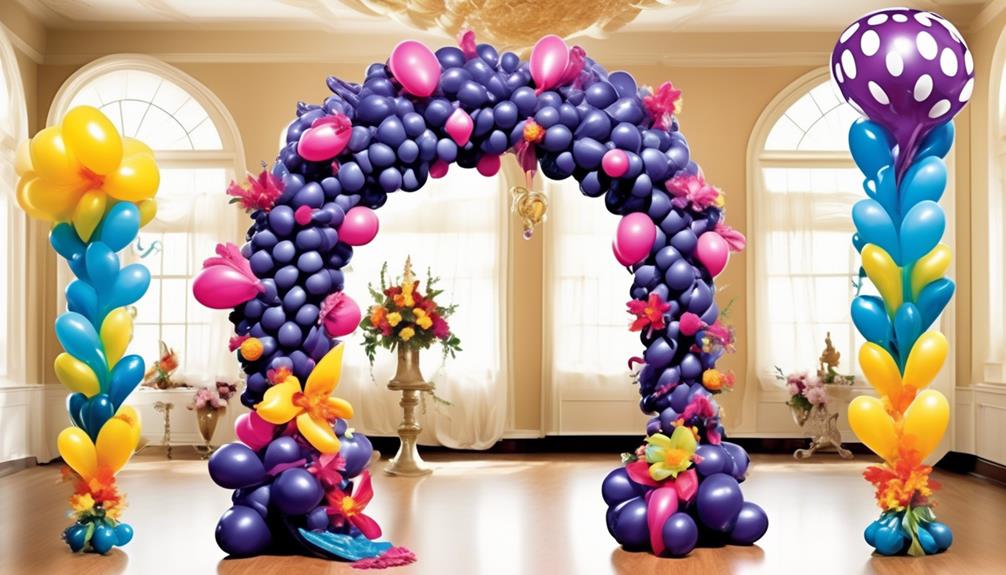
Explore the vibrant world of balloon designs, where creativity and imagination come to life in a myriad of shapes, colors, and themes. When it comes to balloon designs, the possibilities are endless. Get ready to be inspired by the diverse types of balloon designs that you can incorporate into your next event or celebration.
- Balloon Decorations
- Ceiling, wall, and pyramid sculptures
- Gold and paint balloons
- Balloon Crafts
- Modeling and DIY balloons
- Letter balloons and character-themed designs like Spiderman
Whether you’re planning a birthday party, a corporate event, or a themed wedding, there’s a custom balloon design to suit every occasion. From elegant chandeliers to whimsical confetti-filled balloons, the world of balloon designs offers something for everyone.
Imagine the joy on your guests’ faces as they encounter unique and creative balloon designs that elevate the atmosphere of your event. With the option of customizing balloons to match your theme or brand, you can truly make a statement with your balloon decor.
Balloon Design Trends
Amidst the ever-evolving world of event decor, balloon design trends have taken center stage, infusing celebrations with a fresh burst of creativity and innovation. From towering 6-meter-tall pyramids to elegant gold-dipped balloons, the current trends in balloon design are nothing short of spectacular.
Customization options provide a quick and easy way to incorporate specific colors and designs to match any party theme, ensuring that every event is unique and personalized. Balloon arches, garlands, and custom designs with various themes and accents have become immensely popular, adding a touch of whimsy and charm to any occasion.
In the realm of balloon design, the possibilities are endless, and specialized balloon decor services are widely available to bring these trends to life. Houston Deco Balloons, for instance, offers a diverse range of options, from traditional balloon arches to organic balloon decorations, suitable for a wide array of events.
Whether you’re planning a sophisticated wedding, a lively birthday bash, or a corporate event, the current balloon design trends offer an abundance of creative and captivating options to elevate your decor to new heights.
DIY Balloon Design Tips

Get ready to elevate your event decor with these DIY balloon design tips that will add a touch of creativity and charm to any occasion.
- Balloon Arch Magic:
- Create a stunning entrance by crafting a balloon arch using an assortment of colors and sizes to match your event’s theme.
- Incorporate metallic accents or translucent balloons for an elegant touch.
- Organic Balloon Garland Delight:
- Fashion an organic balloon garland by intertwining an array of balloons in various sizes, colors, and textures for a whimsical, free-flowing effect.
- Add in lush greenery or floral accents to infuse a natural, enchanting vibe.
When crafting your DIY balloon designs, consider using a mix of traditional balloon arches and organic balloon garlands to bring your event to life. Customizing balloon colors and designs offers a quick and easy way to match party themes and elevate the festive atmosphere.
With these tips, you can create personalized balloon decor that captures the essence of your celebration, whether it’s a birthday bash, wedding reception, or any special gathering.
Balloon Designs for Different Occasions
Ready to take your event decor to the next level?
Let’s now spotlight the versatility of balloon designs for different occasions, building on the DIY balloon design tips to showcase how these vibrant creations can be tailored to suit various events and celebrations.
Whether it’s a wedding, birthday, corporate event, or parade, balloon decor can elevate the ambiance and aesthetic appeal of any occasion. From stunning sculptures to organic balloon garlands and customizable balloon arches, the options are endless, catering to different themes and preferences.
The beauty of balloon designs lies in their flexibility – with a wide range of colors and designs available, you can effortlessly match specific party themes and maintain a cohesive look. Houston Deco Balloons offers specialized services for creating impactful balloon sculptures and decor, ensuring that your event leaves a lasting impression.
Additionally, balloon bouquets and arrangements are perfect for specific occasions such as birthdays, baby showers, and Mother’s Day, with pricing options ranging from $15.00 to $41.00.
With the right balloon designs, you can truly transform any space into a magical and unforgettable setting for your special event.
Frequently Asked Questions
What Is Balloon Decor Called?
You might call balloon decor ‘balloon art’ or ‘balloon arrangements.’
These creative designs can transform any space, from elegant weddings to fun birthday parties.
With a variety of styles like balloon ceilings, walls, and unique character-themed designs, balloon decor adds a touch of whimsy and elegance to any event.
Whether it’s vibrant party balloons or special custom creations, balloon decor brings joy and excitement to any occasion.
How Do I Make My Own Balloon Arch?
To make your own balloon arch, start by inflating balloons and attaching them to a balloon decorating strip. Create clusters and secure them to a sturdy base, such as PVC piping or a balloon arch stand, to form the arch shape.
Experiment with different balloon placement and color combinations to create a visually appealing arch. Consider adding decorative elements like flowers, foliage, or LED lights to enhance the overall look.
Is Balloon Decorating a Good Business?
Starting a balloon decorating business can be a profitable venture. With high demand and versatility, you can offer a wide range of services for various events.
Customization options allow flexibility to meet specific client preferences. Balloon decorations also offer a budget-friendly alternative, making them an attractive option for clients while ensuring profitability for your business.
With a strong global visibility and social media presence, this can be a lucrative venture in the industry.
How Much Does It Cost to Make a Balloon Arch?
Creating a stunning balloon arch typically costs from $120 to $900, depending on size and design. Customized themes or balloon letters and numbers may vary in price. Factors such as arch type, organic garlands, and specific themes influence cost.
Deluxe designs and organic garlands often fall at the higher end of the spectrum. Tailoring arches to fit themes like Frozen or Mario Bros can also impact the overall cost.
Conclusion
As the balloons float up into the sky, carrying with them the memories of laughter and joy, you can’t help but feel a sense of nostalgia and warmth.
The colorful designs and intricate sculptures added a touch of magic to the occasion, creating a vibrant and unforgettable atmosphere.
Balloon designs have a way of lifting spirits and creating lasting memories, making them a must-have for any celebration.
- About the Author
- Latest Posts
Introducing Ron, the home decor aficionado at ByRetreat, whose passion for creating beautiful and inviting spaces is at the heart of his work. With his deep knowledge of home decor and his innate sense of style, Ron brings a wealth of expertise and a keen eye for detail to the ByRetreat team.
Ron’s love for home decor goes beyond aesthetics; he understands that our surroundings play a significant role in our overall well-being and productivity. With this in mind, Ron is dedicated to transforming remote workspaces into havens of comfort, functionality, and beauty.
Decor
How to Create a Navy Blue Shiplap Wall in 3 Easy Steps
Journey through the transformation of a dull wall into a stunning navy blue shiplap feature wall in just three easy steps.
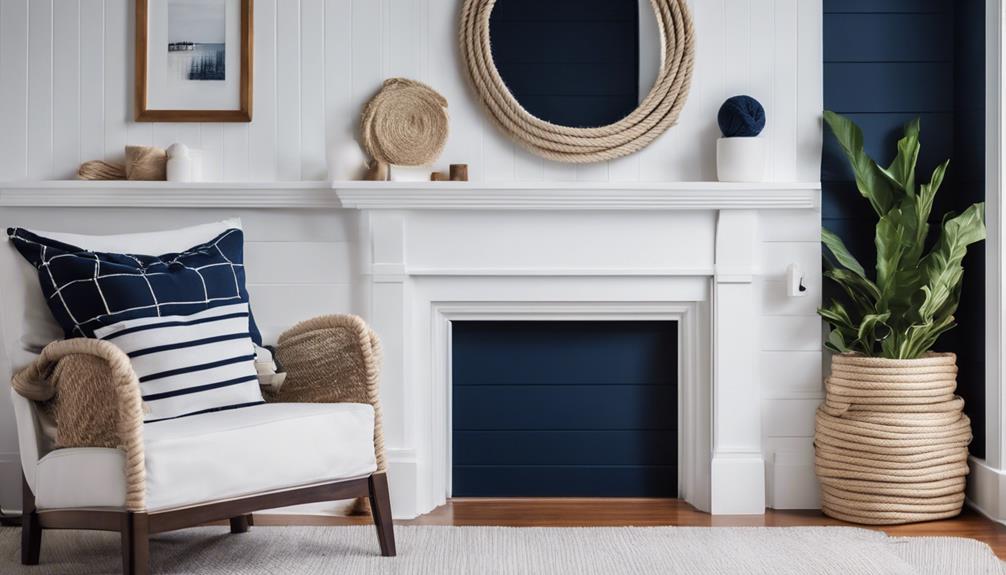
We're transforming our walls into a stunning navy blue shiplap feature wall in just three easy steps. First, we measure and cut our shiplap boards to precision, ensuring accurate fits around corners and edges. Next, we paint the boards a rich navy blue, applying multiple coats with a high-quality paint suitable for wood surfaces. Finally, we install the boards, staggering them randomly for a modern look and securing them with a nail gun and construction adhesive. With these steps, we're well on our way to creating a mesmerizing navy blue shiplap wall – and there's more to explore in this design journey.
Key Takeaways
• Measure the wall area accurately and cut shiplap boards to desired lengths using a table saw or circular saw.
• Paint the boards with high-quality navy blue paint, applying multiple coats and allowing each to dry completely.
• Install the painted boards with a nail gun and construction adhesive, staggering them randomly for a modern look.
Measure and Cut Shiplap Boards
We start by measuring the wall area where we want to install the shiplap boards, using a tape measure to get an accurate reading. This is important in determining how many boards we'll need and guaranteeing a seamless fit.
Once we've the measurements, we mark them on each plywood board using a pencil. Before cutting, we double-check the measurements to ensure accuracy and avoid any errors.
We then cut the plywood boards to the desired lengths using a table saw or circular saw, depending on the complexity of the cut. When cutting, we make sure to maintain precision, especially when dealing with angles for corners or edges of the wall. This attention to detail ensures that our shiplap boards fit together perfectly, creating a beautiful, seamless look.
With our boards cut to size, we're ready to move on to the next step in creating our navy blue shiplap wall.
Paint Boards Navy Blue

Now that our shiplap boards are cut to size, it's time to bring our navy blue vision to life by applying a rich, vibrant coat of paint.
We choose a navy blue paint color that complements our room's decor and style, guaranteeing a cohesive look. For our DIY project, we select a high-quality paint suitable for wood surfaces to make certain of a smooth and long-lasting finish.
To achieve a deep, rich color, we apply multiple coats of navy blue paint to our shiplap boards, allowing each coat to dry completely before applying the next to avoid streaks or uneven coverage. This patient approach pays off, as our boards transform into a stunning navy blue hue.
Finally, we consider adding a protective top coat or sealant to our navy blue painted shiplap wall for added durability and easy maintenance.
With our boards now beautifully painted, we're one step closer to creating a stunning navy blue shiplap wall that adds a touch of sophistication to our room.
Install Shiplap Boards
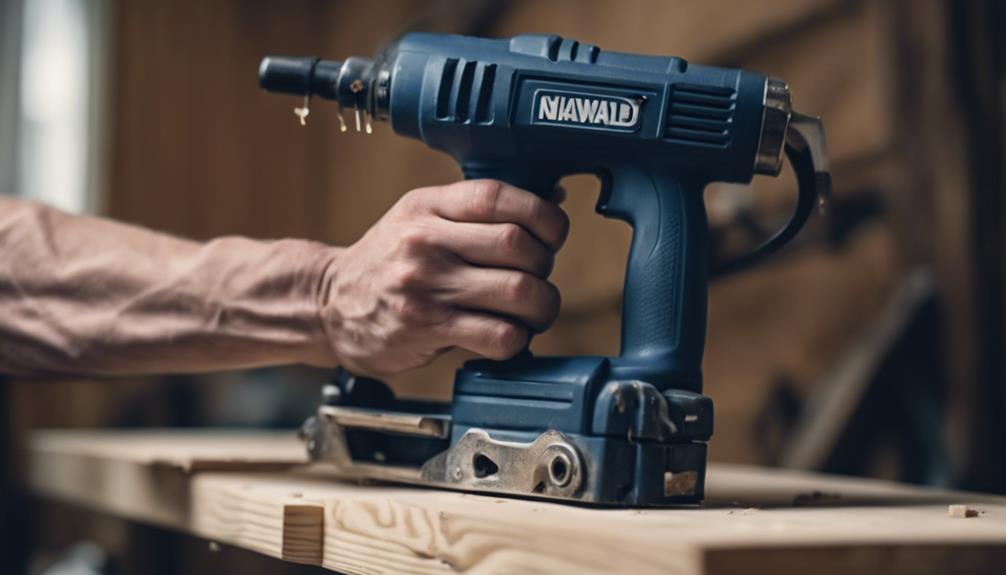
With our navy blue shiplap boards beautifully painted, it's time to bring our design to life by securely attaching them to the wall. We'll start by measuring and cutting the boards to the desired lengths using a miter saw for precision. If needed, we can use a jigsaw to cut around any outlets or obstacles.
Here's a checklist to guarantee a successful installation:
- Secure the boards: Use a nail gun and construction adhesive to attach the shiplap boards to the wall, making sure to space them evenly with spacers.
- Stagger the boards: Randomly stagger the boards to create a modern, visually appealing look.
- Use the right materials: Apply underlayment plywood to the wall before installing the shiplap boards for added durability.
- Finish with care: Fill any nail holes with spackling compound and sand smooth to create a seamless paint line.
At Home Depot, we can find all the necessary materials, including Brad Nails and construction adhesive. By following these steps, we'll have a stunning navy blue shiplap wall that adds a touch of sophistication to any room.
Frequently Asked Questions
How Do You Make a Homemade Shiplap Wall?
We create a homemade shiplap wall by cutting plywood into planks, which we then paint to achieve our desired color.
Next, we secure the planks to the wall using a nail gun and spacers to maintain even spacing.
How Do You Start the First Row in Shiplap?
As we commence our shiplap journey, the first hurdle we face is starting that essential first row. It's like laying the foundation of a skyscraper – get it right, and the rest will follow.
We begin by measuring and marking the top and bottom of the wall, ensuring a straight first row. Then, we use a level to draw a horizontal line, and nail the first board, making sure it's level and flush against the wall.
What Is the New Trend Instead of Shiplap?
We've noticed a shift away from traditional shiplap designs, with many opting for alternative styles instead.
Vertical paneling, for instance, offers a sleek, modern look, while board and batten adds a touch of classic elegance.
Tongue and groove paneling provides a seamless appearance, and geometric patterns like hexagons or diamonds create a unique focal point.
Chevron and herringbone designs are also gaining popularity as a contemporary alternative to shiplap.
Is Shiplap Still in Style in 2024?
We're happy to report that shiplap remains a staple in interior design, still trending in 2024. Its timeless appeal lies in its versatility, allowing it to seamlessly blend with various aesthetics.
The fact that it can be painted in different colors, including navy blue, has contributed to its enduring popularity. As seen in home renovation shows and social media, shiplap continues to captivate homeowners and designers alike, solidifying its status as a sought-after design element.
Conclusion
With our navy blue shiplap wall complete, we've added a touch of sophistication to our space. According to a National Association of Home Builders survey, 65% of homebuyers consider outdoor and interior design features, such as accent walls, essential or desirable.
By following these three easy steps, we've not only elevated our room's aesthetic but also increased its appeal to potential buyers.
Our navy blue shiplap wall is now ready to make a lasting impression.
- About the Author
- Latest Posts
Introducing Ron, the home decor aficionado at ByRetreat, whose passion for creating beautiful and inviting spaces is at the heart of his work. With his deep knowledge of home decor and his innate sense of style, Ron brings a wealth of expertise and a keen eye for detail to the ByRetreat team.
Ron’s love for home decor goes beyond aesthetics; he understands that our surroundings play a significant role in our overall well-being and productivity. With this in mind, Ron is dedicated to transforming remote workspaces into havens of comfort, functionality, and beauty.
Decor
Do You Know All You Need for Making Your Own Table Risers?
Learn the essential materials and design considerations to create custom table risers that elevate your home decor and add a personal touch.
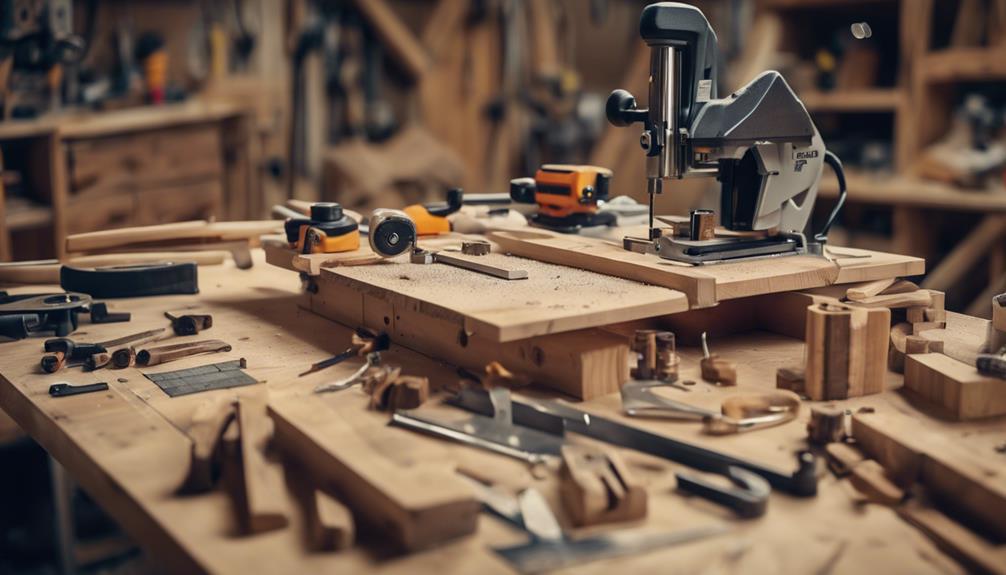
We've got the essentials for making our own table risers! First, we'll need wood planks, screws, wood glue, sandpaper, and wood stain. Next, we'll consider the design, thinking about height, stability, and our home decor style. We can choose from various wood types, like poplar, oak, pine, cedar, or maple, depending on our desired look and durability. Then, we'll build the legs, using materials like wooden blocks, spindles, or even tuna cans and ketchup lids. Finally, we'll add finishing touches, like table runners, centerpieces, and plants. And if we want to get creative, we can customize our riser with paint, stencils, or embellishments.
Key Takeaways
• Consider essential materials like wood planks, screws, wood glue, sandpaper, and wood stain for your table riser project.
• Choose the right wood type, such as poplar, oak, pine, cedar, or maple, based on durability, strength, and aesthetic appeal.
• Design your table riser with considerations for height, stability, and home decor complementarity, and incorporate scrap wood for a unique look.
• Assemble the leg components securely using wood glue and nails or a glue gun, and customize with paint or rustic finishes.
• Add finishing touches with table runners, centerpieces, and accessorizing with plants to create a welcoming atmosphere.
Essential Materials for Table Risers
We'll need a list of essential materials to get started on our table riser project, including:
- Wood planks
- Screws
- Wood glue
- Sandpaper
- Wood stain
These basics will form the foundation of our table, and we can't skimp on quality. The wood planks will serve as the tabletop, while the legs will provide stability and support. We'll use wood glue to bond the legs to the table, guaranteeing a sturdy structure. Sandpaper will come in handy to smooth out any rough edges or surfaces, giving our table a polished finish. Lastly, wood stain will enhance the wood's natural beauty, adding a touch of elegance to our creation.
With these materials in hand, we'll be well on our way to crafting a beautiful and functional table riser.
We'll need to carefully select our wood planks, considering factors like durability and aesthetic appeal. By choosing the right materials, we'll set ourselves up for success and make our table riser turns out exactly as envisioned.
Designing Your Table Riser Project
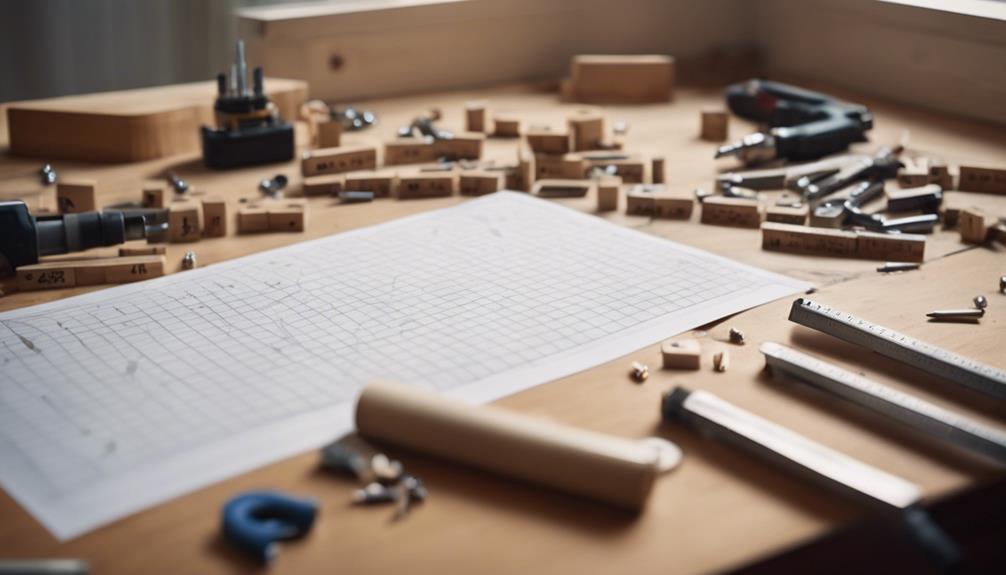
Now that we've gathered our materials, let's get creative and start designing our table riser project. We need to consider the height and stability required to achieve our desired look and functionality. As DIY enthusiasts, we aim to ensure our design complements our home decor and serves its purpose. We can incorporate scrap wood to add a personal touch and reduce waste.
When designing our table riser, we must think about the overall aesthetic we wish to achieve. Do we prefer a modern, sleek appearance or a more rustic, vintage vibe? Experimenting with different leg options, placement, and finishes can help us create a unique piece that reflects our personal style.
To ensure our table riser is sturdy and functional, we must consider the weight capacity and balance. Utilizing online tutorials or DIY guides can provide inspiration and guidance on turning our design into reality.
Choosing the Right Wood Type

Let's explore the world of wood types, where the right choice can make all the difference in our table riser project. We're spoiled for choice, but each type has its unique characteristics that can make or break our project.
Poplar wood, for instance, is a popular choice due to its durability and affordability. Oak wood is another excellent option, known for its strength and attractive grain patterns.
If we're going for a rustic look, Pine wood is a great choice, being easy to work with and offering a natural, distressed appearance. Cedar wood, on the other hand, is a great option if we want a wood type that's naturally resistant to decay and insects.
And for a high-quality finish, Maple wood is the way to go, valued for its durability and beautiful finish. We need to take into account factors like budget, desired look, and durability when selecting the right wood type for our table riser project.
Building the Table Riser Legs
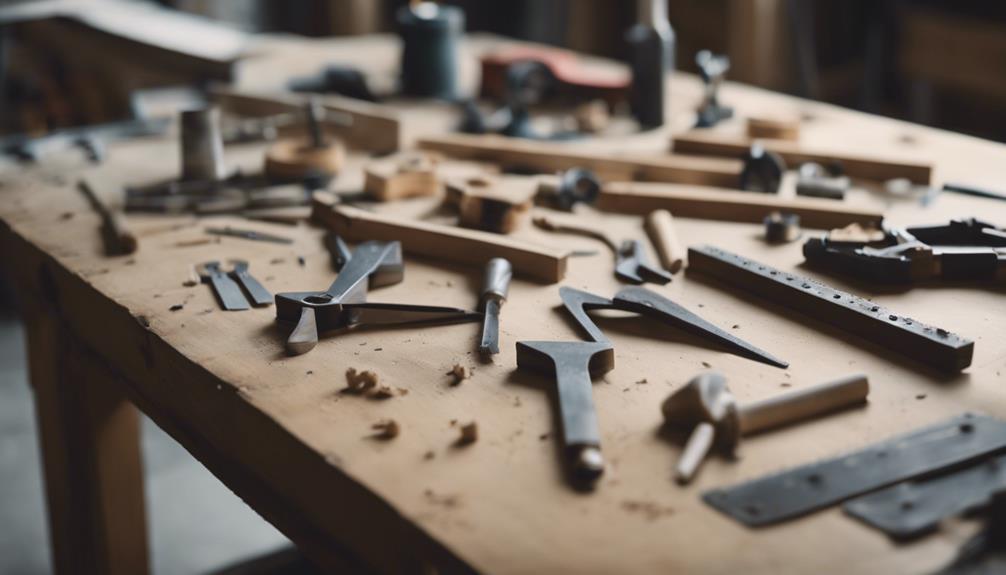
As we build our table riser legs, we'll consider the materials we want to use, taking into account factors like durability and aesthetic appeal.
Next, we'll design the leg structure, thinking about the overall shape and stability of our riser.
Leg Materials Considered
We consider a variety of materials for our table riser legs, from wooden blocks and craft beads to spindles, tuna cans, and ketchup lids. The possibilities are endless, and it's exciting to experiment with different leg materials to achieve a unique and personalized design for our table risers.
When choosing leg materials, we consider the desired height, stability, and overall look of our table risers. Here are some key factors to keep in mind:
- Stability: Wooden blocks and spindles provide a sturdy base for our table risers, while craft beads can add a touch of whimsy.
- Height: Tuna cans and ketchup lids can be stacked to achieve the perfect height for our table risers.
- Aesthetics: Mixing and matching different leg materials can create a one-of-a-kind design for our DIY table risers.
Designing Leg Structure
We're constructing our table riser legs by combining our chosen materials in creative ways to achieve the perfect structure and design. For our DIY table risers, we're experimenting with unique leg structures using wooden blocks, craft beads, spindles, tuna cans, or ketchup lids.
We're placing the legs strategically near the edges or center of the base to achieve the desired aesthetic. To guarantee stability and support for our table riser, we're securing the legs with nails, staples, or a glue gun.
We're customizing the leg design by adjusting positions and combining various wooden spindle parts for a personalized look. We're also considering painting or leaving a rustic finish to enhance the overall design of the table riser.
Assembling Leg Components
Let's get our DIY project underway by attaching the leg components to the table riser base, establishing a sturdy foundation for our creation. This essential step requires attention to detail to guarantee our table riser is stable and durable.
To assemble the leg components, we'll focus on three key aspects:
- Secure attachment: Use wood glue to bond the legs to the table riser base, ensuring a strong and long-lasting connection.
- Proper alignment: Align the legs carefully to ensure stability and balance. A pin nailer can provide additional reinforcement for extra security.
- Consistency is key: Ensure all legs are identical in size and placement to maintain the overall stability and durability of the table riser.
Adding Finishing Touches and Decor
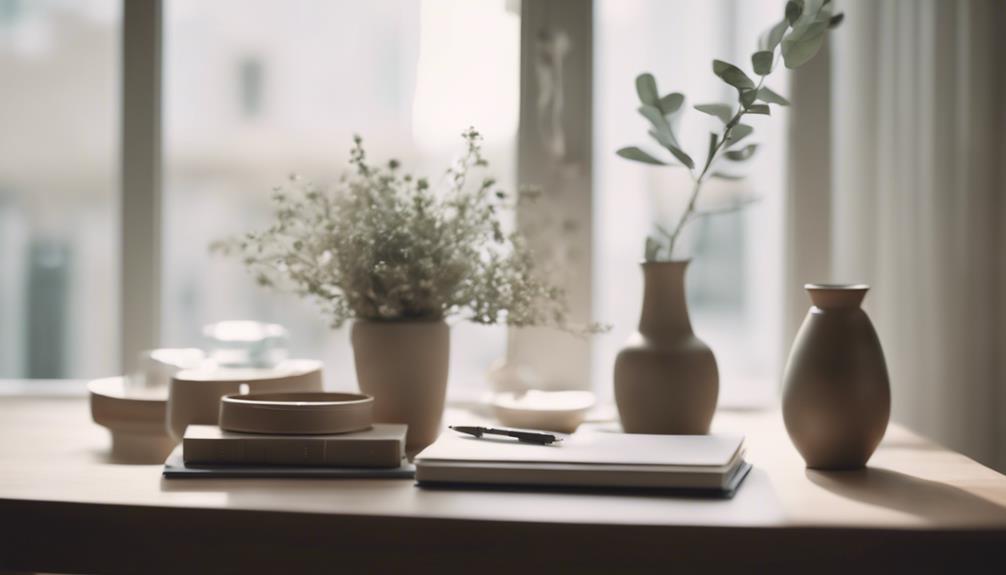
Now that our table risers are built, we're excited to add some personality to them.
We'll explore some creative ways to make our risers shine, from choosing the perfect table runner to displaying beautiful centerpieces and even adding some greenery with plants.
Table Runner Options
With a wide range of materials and styles to choose from, we can easily find a table runner that complements our unique taste and decor. Whether we're going for a rustic farmhouse look or a modern home decor vibe, there's a table runner to match. We can opt for cotton, linen, burlap, or silk, each offering a distinct texture and aesthetic.
Here are some tips to keep in mind when choosing a table runner:
- Seasonal style: Switch up your table runner to match the season or holiday.
- Layer it up: Use a table runner with a tablecloth for a more elaborate look.
- Get creative: DIY a table runner using fabric, ribbon, or repurposed materials for a one-of-a-kind touch.
When building our DIY table, including a table riser, we want to make sure our decor is on point. A well-chosen table runner can elevate our DIY farmhouse table from simple to stunning. By selecting the right material, style, and design, we can create a warm and inviting atmosphere that reflects our personal taste and complements our home decor.
Centerpiece Ideas Found
Incorporating decorative elements into our table riser centerpiece allows us to add a personal touch and create a warm, inviting atmosphere that reflects our unique style. We can experiment with different heights and sizes of table risers to create visual interest and dimension in our centerpiece display. Mixing and matching textures, colors, and materials can create a cohesive and eye-catching arrangement on our DIY table riser.
Here are some centerpiece ideas to get us started:
| Centerpiece Idea | Description |
|---|---|
| Seasonal Delight | Use themed or seasonal items like pumpkins, pinecones, or ornaments to create a festive centerpiece |
| Candle Glow | Add ambiance with candles in mercury glass holders or apothecary jars |
| Floral Fusion | Combine fresh flowers or greenery with decorative vases or containers |
We can also consider using a table runner, placemats, or a decorative tray to enhance the overall look of our table setting. By adding personalized decorations, we can create a one-of-a-kind centerpiece that showcases our style and flair. With a little creativity, our DIY table riser can become a stunning focal point in any room.
Accessorizing With Plants
We can take our table riser decor to the next level by adding some greenery, which not only freshens up the space but also brings a touch of natural elegance to our centerpiece. Adding plants to our table risers can create a welcoming and lively atmosphere in our living space.
Here are some tips to keep in mind when accessorizing with plants:
- Choose the right plants: Select plants that complement the style and color scheme of your room for a cohesive look. Succulents, air plants, or small potted herbs are great options for tabletop plant decor.
- Elevate with hanging plant brackets: Consider using hanging plant brackets to elevate your plants on the table risers, adding visual interest and depth to your decor.
- Keep it simple: Don't overcrowd your table risers with too many plants. A simple, minimalist approach can be just as effective in adding a touch of elegance to your space.
Tips for Customizing Your Riser

We can create a truly one-of-a-kind table riser by experimenting with different materials, shapes, and sizes that reflect our personal style.
To customize our table riser, we can choose from various materials like wood, metal, or repurposed items that fit our decor. We can also experiment with different shapes and leg designs to create a unique look.
Painting, staining, or distressing our riser can give it a customized finish that matches our home decor. Adding decorative elements like stencils, decals, or embellishments can further personalize our riser.
We shouldn't be afraid to mix and match different components to achieve a one-of-a-kind design.
Frequently Asked Questions
How to Make Your Own Table Risers?
We're excited to start creating our own table risers! To get started, we'll gather materials like wood planks, screws, a drill, and stain or paint.
We'll sand and stain or paint the wood plank to achieve the desired look.
Next, we'll attach hanging plant brackets securely to the wood plank using screws, drilling pilot holes to guarantee stability.
With these simple steps, we'll create sturdy and functional table risers that elevate our workspace or decor.
How to Make a DIY Riser?
We're excited to start creating our own DIY riser! To get started, we'll need some essential materials like wood planks, screws, a drill, and stain or paint.
We'll sand and stain the wood to give it a personalized touch, then attach plant hanging brackets securely using provided screws.
What Can I Use for Riser Legs?
We're getting creative with our table riser legs! We can repurpose wooden blocks, craft beads, spindles, tuna cans, or even ketchup lids as unique legs.
We'll secure them with nails, staples, or a glue gun for stability. Experimenting with leg placements near edges or the center of the base will give us a one-of-a-kind look.
We can even paint or distress the legs to match our decor style. The possibilities are endless, and we can't wait to see our personalized risers come to life!
What Can You Use for Risers?
We can use a variety of materials for our table risers. We're not limited to traditional options – we can repurpose old items like picture frames, cutting boards, or spindles for unique risers.
We can also explore unconventional materials like tuna cans, ketchup lids, or wooden blocks for a creative touch. Additionally, we can salvage parts like bed posts, antique door pieces, or vintage elements for a rustic feel.
The possibilities are endless!
Conclusion
Now that we've walked through the process of creating our own table risers, we can confidently say that building one is like baking a cake – it requires the right ingredients, a clear recipe, and a dash of creativity.
With the essential materials, a well-designed plan, and some TLC, we can craft a sturdy and stylish table riser that elevates our workspace or dining area.
By following these steps, we can create a functional piece that's both beautiful and functional, and that's the icing on the cake!
- About the Author
- Latest Posts
Introducing Ron, the home decor aficionado at ByRetreat, whose passion for creating beautiful and inviting spaces is at the heart of his work. With his deep knowledge of home decor and his innate sense of style, Ron brings a wealth of expertise and a keen eye for detail to the ByRetreat team.
Ron’s love for home decor goes beyond aesthetics; he understands that our surroundings play a significant role in our overall well-being and productivity. With this in mind, Ron is dedicated to transforming remote workspaces into havens of comfort, functionality, and beauty.
Decor
Pergola Remodel
Outdoor oases await as we delve into the world of pergola remodels, revealing secrets to elevate functionality, style, and property value.
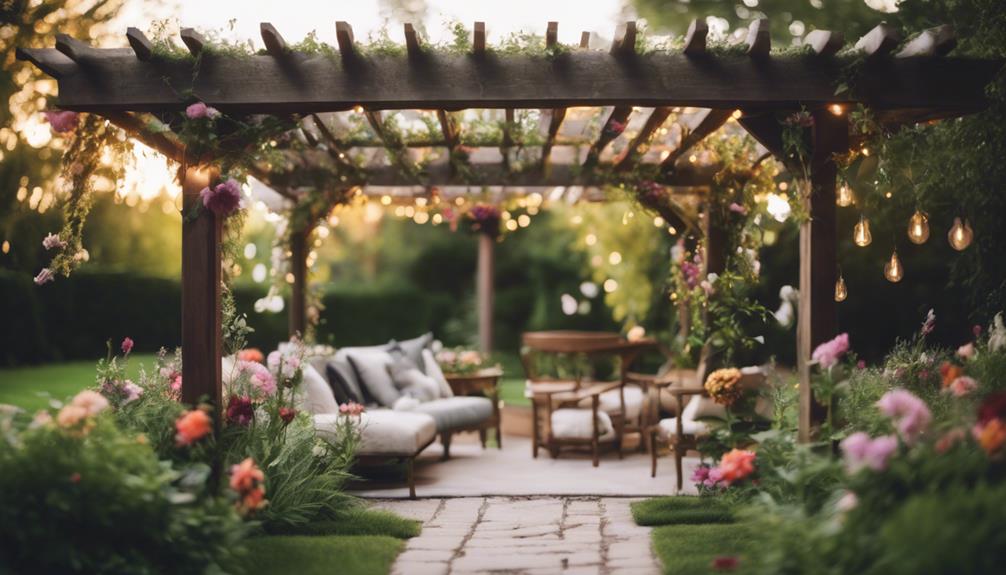
We undertake pergola remodels to elevate our outdoor spaces, with a staggering 70% of homeowners citing a desire for improved functionality and aesthetic appeal. To achieve this, we consider the purpose of the pergola, define necessary amenities, and think about the overall aesthetic. We choose materials that withstand the elements, incorporating durable options like redwood or cedar, and consider eco-friendly alternatives. By designing for functionality, incorporating modern features, and adding aesthetic appeal, we can create an inviting outdoor space that increases our property value. As we explore pergola remodels further, we'll uncover more ways to transform our outdoor living spaces.
Key Takeaways
• Define the pergola's purpose and necessary amenities to create a functional and inviting space that increases property value.
• Choose durable, weather-resistant materials like redwood, cedar, or eco-friendly options that balance aesthetics, durability, and cost-effectiveness.
• Incorporate functional features like built-in seating, retractable shades, and lighting fixtures to enhance outdoor living and entertainment.
• Add aesthetic appeal with design elements, stain or paint colors, climbing plants, and lighting fixtures that complement the home's exterior.
• Consider modern features like aluminum, composite materials, smart technology, and contemporary designs to create a sleek and functional oasis.
Planning Your Pergola Remodel
As we begin our pergola remodel, let's pause to assess how we envision using this outdoor space, ensuring our design aligns with our needs and desires.
A wooden pergola can be a stunning addition to our backyard, but we must consider its purpose before starting the project. Will it serve as a relaxation area, a dining space, or an entertainment hub? By defining its function, we can determine the necessary amenities, such as lighting, seating, and storage.
We should also think about the overall aesthetic we want to achieve, taking into account the style of our home and the surrounding landscape. By doing so, we can create a cohesive and inviting space that complements our property.
A well-planned pergola remodel won't only enhance our outdoor living experience but also increase our property's value. By taking the time to plan and prioritize our needs, we can create a beautiful and functional wooden pergola that exceeds our expectations.
Choosing the Right Materials
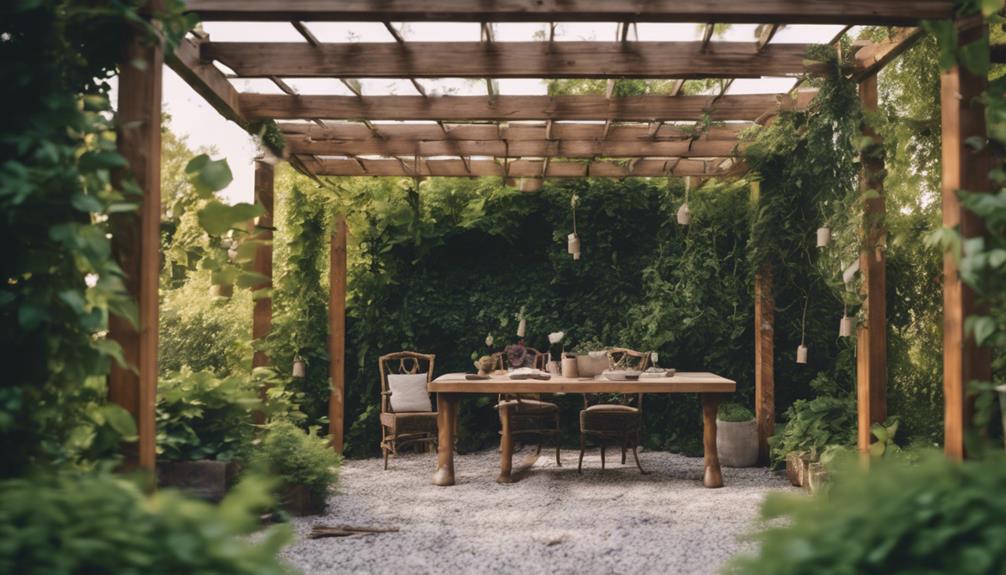
With our purpose and aesthetic in mind, we're ready to select the materials that will bring our pergola remodel to life.
As we're creating an outdoor living space, it's important to choose materials that can withstand the elements. We're considering durable options like redwood or cedar for a long-lasting pergola renovation.
Alternatively, weather-resistant materials such as aluminum or vinyl offer minimal maintenance, making them an attractive choice. It's vital to select materials that complement our home's exterior design for a cohesive look.
We're also exploring eco-friendly options like reclaimed wood or composite materials to reduce our environmental footprint. Ultimately, we're looking for materials that strike a balance between aesthetics, durability, and cost-effectiveness.
Designing for Functionality
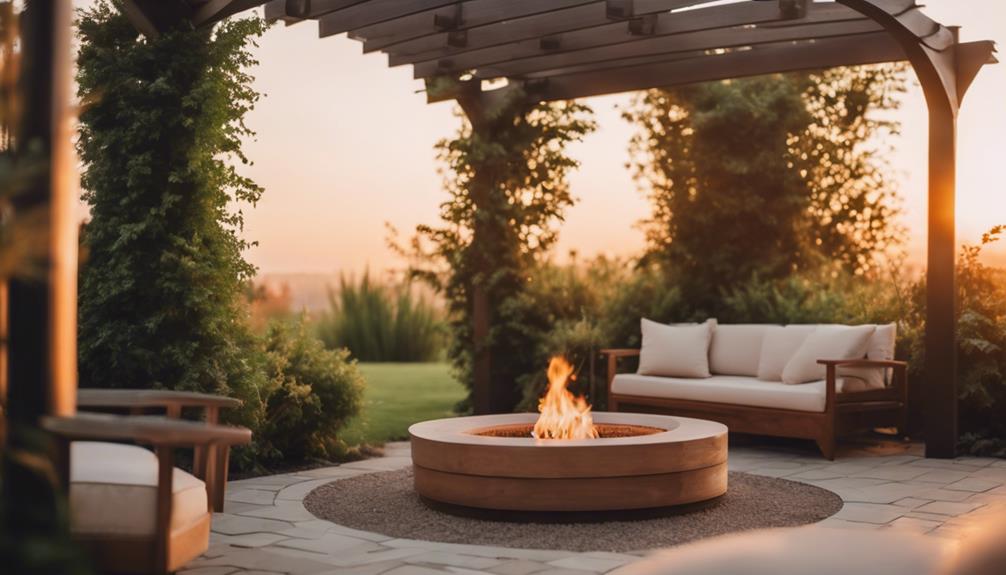
We're now turning our attention to designing our pergola for functionality, ensuring it seamlessly integrates into our outdoor living space. When it comes to functionality, we want our pergola to be more than just a pretty face. We want it to be a hub for outdoor dining, relaxation, and entertainment.
| Functionality Feature | Description |
|---|---|
| Built-in Seating | Incorporate benches or seating areas for comfortable lounging |
| Retractable Shades | Add shades or curtains for sun and rain protection |
| Lighting Fixtures | Install lights to extend functionality into evening hours |
| Durable Materials | Choose weather-resistant materials for longevity |
| Storage Solutions | Add storage for outdoor accessories and decor |
Adding Aesthetic Appeal
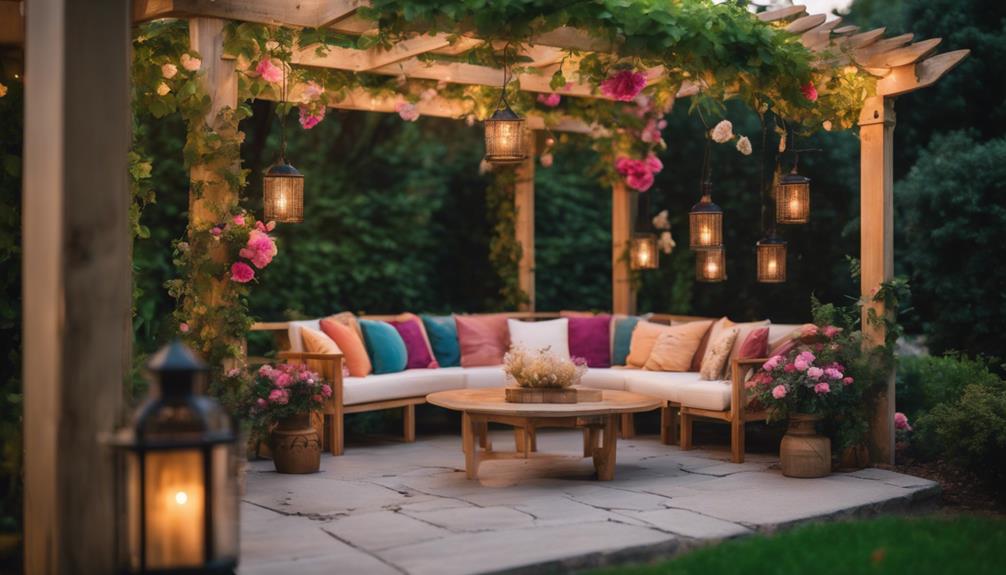
In addition, optimizing our pergola for functionality is essential, but now let's shift our focus to adding aesthetic appeal. We can incorporate design elements that elevate its visual appeal and create an inviting atmosphere.
When it comes to adding aesthetic appeal, the devil is in the details. Incorporating design elements like lattice work and decorative braces can add visual interest to the pergola, making it a stunning focal point in our outdoor space. We can also choose a stain or paint color that complements our home's exterior, tying the pergola into the overall design.
Adding climbing plants or vines can create a lush and inviting atmosphere, making our pergola feel like a serene oasis. Moreover, utilizing lighting fixtures or hanging lanterns can enhance the ambiance of the pergola during evening gatherings, making it the perfect spot to relax and socialize.
Incorporating Modern Features

As we move forward with our pergola remodel, we're excited to explore the modern features that can elevate our outdoor space.
We'll examine how incorporating contemporary materials and designs can transform our pergola into a sleek and functional oasis.
From modern materials like aluminum and composite wood to smart technology integrations, we'll discuss how these elements can come together to create a truly modern pergola.
Modern Materials Matter
By incorporating modern materials like aluminum and composite wood into our pergola remodel, we can create a structure that's not only visually stunning but also incredibly durable. These modern materials matter because they offer a range of benefits that enhance the overall pergola design.
For instance, aluminum is a sleek and minimalist material that can be used to create a modern pergola's framework. Composite wood, on the other hand, provides a durable and low-maintenance alternative to traditional wood. By combining these materials, we can create a pergola that's both stylish and long-lasting.
Moreover, modern materials allow us to integrate advanced features like automated louvers and integrated speakers, which elevate the functionality and convenience of our pergola. With modern materials, we can seamlessly blend indoor and outdoor spaces, creating a cohesive and modern design.
Contemporary Designs Shine
We're drawn to contemporary pergola designs that incorporate modern features, which transform outdoor spaces into sophisticated retreats that seamlessly blend function and style.
These designs often include advanced features like automated louvers and integrated speakers, creating a unique and luxurious ambiance. By incorporating matching design elements, modern pergolas can blur the boundaries between indoor and outdoor spaces, creating a cohesive look.
Rooftop pergolas, in particular, can serve as private sitting areas shielded from the elements, creating urban oases in the midst of bustling cities.
Advanced materials like aluminum are used in contemporary pergola designs, providing a sleek and modern look. Additionally, vine-covered pergolas can create a seamless connection between different areas, enhancing the overall living experience.
Transforming With Color
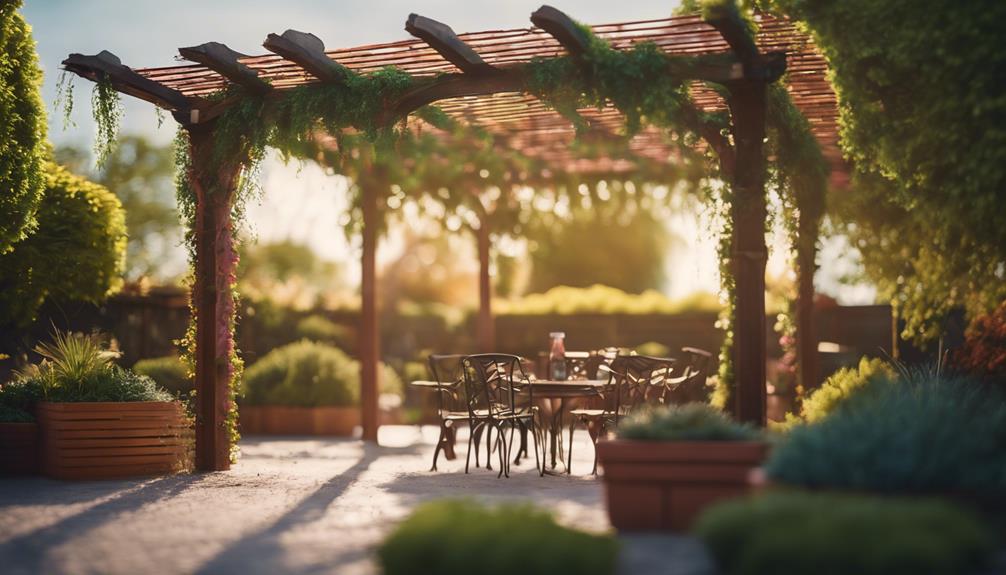
What if a simple splash of color could elevate your pergola from ordinary to extraordinary? We're excited to explore the transformative power of color in our pergola remodel.
When it comes to patio ideas, adding a pop of color can completely revamp the ambiance of our outdoor space. Take, for instance, a soothing sky blue hue that creates a serene and calming atmosphere, perfect for relaxation.
By experimenting with paint colors, we can add personality and style to our pergola design. A blue-painted pergola can beautifully complement the surrounding greenery and nature in our outdoor area.
On the other hand, vibrant colors can create a fun and inviting space for relaxation. The possibilities are endless, and we're excited to see how a simple coat of paint can transform our pergola into a stunning focal point.
With a little creativity, we can turn our ordinary pergola into an extraordinary oasis that reflects our unique style and personality.
Blending Indoors and Outdoors

As we remodel our pergola, we're looking to create a seamless connection between our indoor and outdoor spaces. We want to blur the lines between the two areas, creating a sense of continuity that makes our outdoor living extensions feel like a natural part of our home.
Seamless Transitions
By intentionally designing our pergola with matching elements, we can effortlessly merge our indoor and outdoor spaces, creating a seamless flow between the two. This harmonious blend is essential in crafting a cohesive atmosphere that flows effortlessly from one area to another.
A well-designed seating area, for instance, can be a perfect spot to relax and enjoy the outdoors while still being connected to the indoors. To achieve this, we can incorporate design elements that match our indoor decor into our pergola, ensuring a smooth connection between different areas.
A vine-covered pergola, for example, can create a cohesive link between indoor and outdoor areas, blurring boundaries and enhancing the sense of continuity. Additionally, using natural wood in our pergola can add an organic feel, connecting us to nature.
Outdoor Living Extensions
We're taking our living experience to the next level with outdoor living extensions like pergolas that seamlessly merge our indoor and outdoor spaces. By incorporating design elements that match our indoor spaces, we can blur the boundaries between indoors and outdoors, creating a cohesive living experience.
In Los Angeles, where outdoor living is a staple of the lifestyle, pergolas have become a popular choice for extending the functionality of indoor areas into the outdoors. Vine-covered pergolas, in particular, create a natural shift between indoor and outdoor living spaces, making it difficult to distinguish where one ends and the other begins.
Creating a Private Oasis

With flowing drapes, canopies, and climbing plants, we can transform our pergola into a secluded retreat that's all our own. By incorporating these elements, we can create a private oasis in our backyard.
For instance, adding flowing drapes can block out the outside world, providing an intimate atmosphere. A canopy can provide abundant shade, making our pergola feel like a secluded hideaway. Additionally, incorporating climbing plants like grapevines and ivy can enhance privacy, making our pergola feel like a secluded retreat.
If you're looking to take your pergola to the next level, contact us to explore your options. We can help you design a private oasis that's tailored to your needs. Whether you're looking to create a romantic getaway or a peaceful escape, we can help you achieve your vision.
Enhancing Outdoor Living
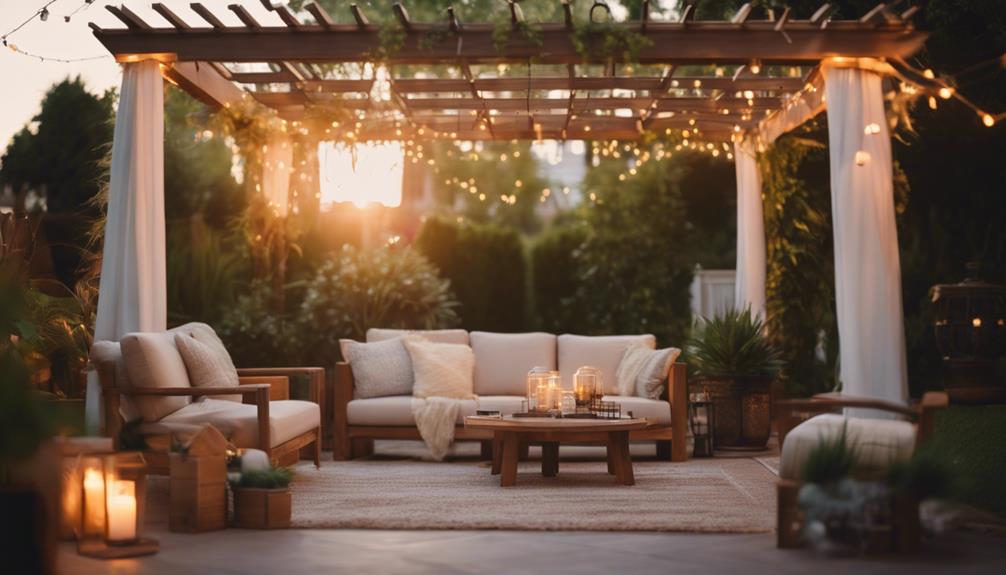
As we step out of our private oasis, we can further enhance our outdoor living experience by incorporating pergola remodels that seamlessly blend functionality and style. By doing so, we can create an inviting atmosphere that's perfect for relaxation and entertainment.
A well-designed pergola can transform our outdoor space into a cozy retreat, providing shade and privacy while amplifying the aesthetic appeal of our backyard. Whether we're looking to host outdoor gatherings or simply unwind after a long day, a pergola remodel can help create an idyllic setting.
Additionally, upgrading or renovating a pergola can increase our home's value and curb appeal, making it a worthwhile investment for homeowners. By incorporating a pergola into our outdoor space, we can maximize its full potential, turning it into an extension of our living area.
As we continue to enhance our outdoor living experience, we can reap the benefits of a beautifully designed pergola that complements our home and lifestyle.
Frequently Asked Questions
Is It Cheaper to Build or Buy a Pergola?
When considering a pergola, we often wonder: is it cheaper to build or buy one? The answer depends on several factors.
Building a pergola can be cost-effective, with DIY materials ranging from $1,500 to $3,000. However, purchasing a pre-made pergola can cost between $2,000 to $5,000 or more, depending on size and materials.
Labor costs for building a pergola add to the expense, while DIY projects save on installation fees.
How Do You Upgrade a Pergola?
We often assume that upgrading a pergola means replacing it entirely, but that's not necessarily true. In reality, upgrading can be as simple as adding new support legs or a lattice design to enhance stability and aesthetics.
We can also refresh the look with a new stain or paint color, or boost shade coverage with additional slats or a canopy.
How Do You Refurbish a Pergola?
When refurbishing a pergola, we start by inspecting the structure to identify areas that need improvement. We replace old or rotten wood with durable materials like Redwood lumber to guarantee longevity.
Next, we update the shade canopy by adding new rafters and slats for better coverage.
Does a Pergola Add Value to Property?
Imagine a for-sale sign on a property that screams 'buy me!' – that's what a pergola can do.
We've got the stats to back it up: according to the National Association of Realtors, a pergola can increase property value by up to 20%!
It's no wonder why; these structures add visual appeal, create extra living space, and boost curb appeal.
Conclusion
As we conclude our pergola remodel journey, we're reminded that 75% of homeowners consider outdoor living spaces a top priority. It's no wonder, given the transformative power of a well-designed pergola.
By choosing the right materials, designing for functionality, and incorporating modern features, we can create a seamless blend of indoors and outdoors.
With a focus on aesthetics, color, and privacy, our pergola remodel becomes a serene oasis, perfect for relaxation and connection.
- About the Author
- Latest Posts
Introducing Ron, the home decor aficionado at ByRetreat, whose passion for creating beautiful and inviting spaces is at the heart of his work. With his deep knowledge of home decor and his innate sense of style, Ron brings a wealth of expertise and a keen eye for detail to the ByRetreat team.
Ron’s love for home decor goes beyond aesthetics; he understands that our surroundings play a significant role in our overall well-being and productivity. With this in mind, Ron is dedicated to transforming remote workspaces into havens of comfort, functionality, and beauty.
-

 Vetted6 days ago
Vetted6 days ago15 Best Printers of 2024: Top Picks and Expert Reviews
-

 Vetted1 week ago
Vetted1 week ago15 Best Tile Sealers for Long-Lasting Protection and Shine
-

 Vetted2 weeks ago
Vetted2 weeks ago15 Best Smelling Floor Cleaners That Will Leave Your Home Fresh and Inviting
-

 Vetted1 week ago
Vetted1 week ago14 Best Power Scrubbers for Showers That Will Transform Your Cleaning Routine
-

 Vetted3 days ago
Vetted3 days ago15 Best LED Dimmer Switches With No Flicker: Ultimate Guide for a Flicker-Free Lighting Experience
-

 Vetted3 days ago
Vetted3 days ago15 Best Evergreen Plants for Shade Gardens: A Complete Guide
-

 Mardi Gras Decoration5 days ago
Mardi Gras Decoration5 days agoWhat Do the Symbols of Mardi Gras Mean?
-

 Appliances1 week ago
Appliances1 week ago5 Best Energy-Efficient Stainless Steel Fridges 2023




